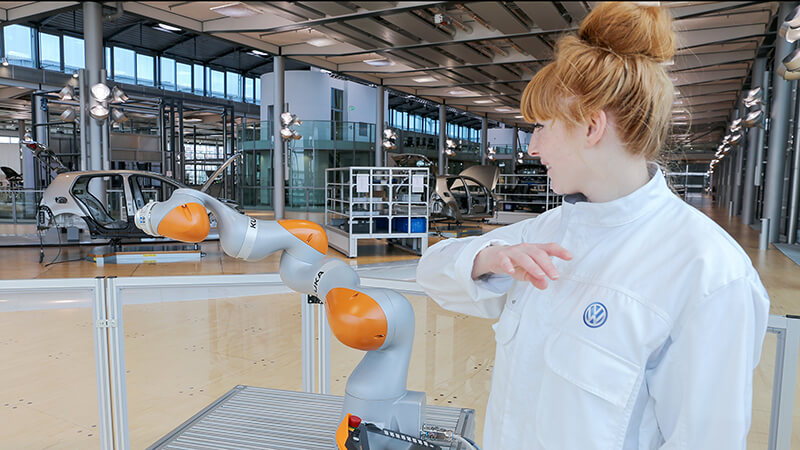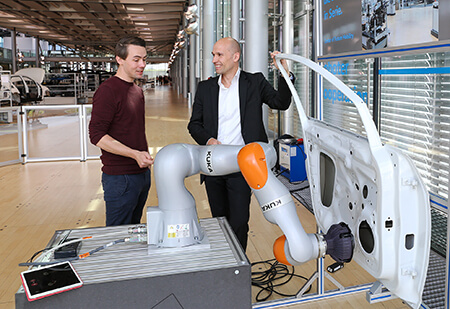 Volkswagen’s Transparent Factory in the eastern German city of Dresden is arguably one of the more unusual automotive manufacturing sites in the world. Named due to its highly glazed exterior, it is not only the production location for the company’s e-Golf but also home to a number of other related activities. These include acting as a showpiece for the automotive industry, by allowing members of the public to get within a few feet of the production line; and being an ‘incubator’ for VW’s mobility-related technologies through collaboration with start-ups.
Volkswagen’s Transparent Factory in the eastern German city of Dresden is arguably one of the more unusual automotive manufacturing sites in the world. Named due to its highly glazed exterior, it is not only the production location for the company’s e-Golf but also home to a number of other related activities. These include acting as a showpiece for the automotive industry, by allowing members of the public to get within a few feet of the production line; and being an ‘incubator’ for VW’s mobility-related technologies through collaboration with start-ups.
Since early this year, VW has also been working at the site with a company called Wandelbots, a local operation that was founded in 2017 to bring to market a new technique for programming industrial robots, which aims to dispense entirely with the need for specialist skills.
The Wandelbots technique involves a programmer using a jacket fitted with an array of sensors and actuators, linked to a robot via a computer. The programmer’s physical movements are recorded and ultimately translated into corresponding robot motions.
Marco Weiss, head of new mobility and innovations for VW at Dresden, says the technology came to his attention when he was giving a talk at the city’s Technical University, where it was originally developed, and that he immediately recognised its potential for helping to solve a common problem in industry – the time delays in production schedules often caused by a shortage of skilled robot programmers.
Such delays, he says, are something VW has experienced in its own operations. “There aren’t enough staff to satisfy demand for programming new robot solutions,” he states. This not only inhibits current operations but also future plans to implement robotics in other aspects of production, he adds.
“We want to extend automation out from the bodyshop and paintshop to include assembly operations as well,” Weiss explains. The major robotics suppliers that VW deals with at present, he says, “simply did not have a solution they could offer”.
 “There aren’t enough staff to satisfy demand for programming new robot solutions… We want to extend automation out from the bodyshop and paintshop to include assembly operations as well.” - Marco Weiss, VW
“There aren’t enough staff to satisfy demand for programming new robot solutions… We want to extend automation out from the bodyshop and paintshop to include assembly operations as well.” - Marco Weiss, VW
Wandelbots CEO and one of its six co-founders, Christian Piechnick, says that although the company only formally came into existence in December last year, its origins can be traced back to research work carried out in Dresden’s Technical University over the previous five years. He is adamant that the capability the company has to offer is unique, stating: “There is nothing comparable available on the market”.
While talks between the two parties only started in January, an agreement to work together was soon reached and a test cell was set up in the Transparent Factory in March. Apart from Wandelbots’ own kit, the cell is equipped with a Kuka iiwa robot with a 14kg lifting capacity, suitable for use in a human-robot collaborative working environment, and some further equipment such as vision systems for object recognition.
Testing the conceptSo far, three pilot projects have been carried out or planned for implementation, each of them using a specific e-Golf application as its focus.
The first has involved the fitting of a loudspeaker to the vehicle’s door, a task currently carried out manually, but which is awkward for the operator because of the combination of part manoeuvring and screwing into place.
“Ideally, the operator needs a third hand, so we thought: why couldn’t that be a robot?” Weiss states, adding that VW has tested an approach in which the part handling is taken care of by the robot, leaving the operator free to concentrate on the more complex fixing process.
The second project has involved applying adhesive stickers to the inside of car doors, a process which Weiss says is “inefficient” when carried out by a human and could be greatly improved if performed by a robot.
[mpu_ad]The third project, which is still at the planning stage, is much more challenging and involves the tightening of 16 screws holding in the vehicle’s safety bulb. Beyond the installation process itself, Weiss points out, it is “also necessary to document the torque”.
This third project involves at least one other partner, which Weiss will not identify, saying only that the focus is on using sensor devices to ensure the safety of human operators working in close proximity to the robot. He says he hopes that real project work will begin in the test cell by the end of the year.
By then, Weiss suggests, the loudspeaker application will have gone live as a real-world production procedure. “Our target is to achieve that by the end of this year,” he confirms, explaining that the work in the test cell so far has convinced VW that the approach is truly credible as a production programming technique.
“We have seen that the teaching is very fast,” Weiss says, adding that the optimisation of the process through the system’s artificial intelligence capability is another feature that has been vindicated. The task facing VW before it can implement the technology for real, he says, is to ensure it will comply with all relevant legislation covering the safety of people working in close proximity to robots.
After that, Weiss says, there are no obvious limitations to potential application of the technique, whether in terms of geography or task. “We want to be able to push it out to VW plants worldwide,” he states.
Interestingly, he also says that VW expects it to have some application in the programming of heavy standalone robots, though perhaps only for “major initial movements”, with fine-tuning carried out later via more conventional programming techniques.
Logistics applicationsAccording to Weiss, VW sees potential for the Wandelbots technology in wider logistics operations. He suggests the technique might be used, for example, to program a robotic arm mounted on a ‘shopping cart’ or some form of mobile stand to assist with selection and picking of parts from containers. In such an application, the robot could hand the part directly to an assembly worker, carrying out all selection and handling routines for a part prior to its addition to a vehicle.
The potential savings that could bring would be considerable. “One-third of the logistical costs in the brand are associated with sequencing,” he comments.
But as well as helping to get things right, Weiss suggests that the technique could also come in useful in programming robots to undo mistakes.
 “We want to hide all the complexity from users. Basically you just show the robot what you want it do a few times so that the software learns the process.” - Christian Piechnick, Wandelbots
“We want to hide all the complexity from users. Basically you just show the robot what you want it do a few times so that the software learns the process.” - Christian Piechnick, Wandelbots
“It could enable robots to be used for repacking operations instead of people, when parts have got into the wrong container,” he says. More routine tasks, he explains, might include the “breaking-up of large lots of parts into smaller ones” and “the delivery of small load-carriers to an assembly line and their exchange with empty ones”.
Weiss stresses that the full potential of the Wandelbots technology has yet to be determined and will be subject to further exploration – not least, to identify what other technologies might complement it most effectively.
De-skilling the processBack at Wandelbots, Piechnick says the impetus to develop the technology grew from a perception that existing robot programming techniques were simply too slow and inflexible to meet changing demands.
There are often just not enough people with the appropriate skills to meet the need for frequent reprogramming in environments characterised by short-run production schedules arising from continuous product modifications, he says, which explains the company’s aim to completely ‘de-skill’ robot programming.
“We are developing a product that will allow anyone, regardless of their technical background, to program an industrial robot,” he explains. “We want to hide all the complexity from users. Basically you just show the robot what you want it do a few times so that the software learns the process and then generates the code to enable the robot to perform the task autonomously.”
Piechnick says the hardware comprises standard components such as accelerometers and gyroscopes in the jacket. Intriguingly, it also makes use of the same technology found in the ‘home’ button of an Apple iPhone to enable a flat sheet of material to imitate the tactile response of a button-push.

The software to drive the whole system is also component-based, he says, being configured as a number of small, separate but interlinked modules. An important implication of this is that the software being run becomes indifferent to the source of computing power that drives it. It can operate in part on local hardware and in part on a remote server.
At the time of writing, Piechnick, whose company now employs 15 people, said he was expecting the first commercially available version of the technology to appear on the market under the name of Wandelbox around the end of September.
Programming robots, it seems, might just have become something anyone can do.

























![Global[1]](https://d3n5uof8vony13.cloudfront.net/Pictures/web/a/d/s/global1_726550.svgz)









